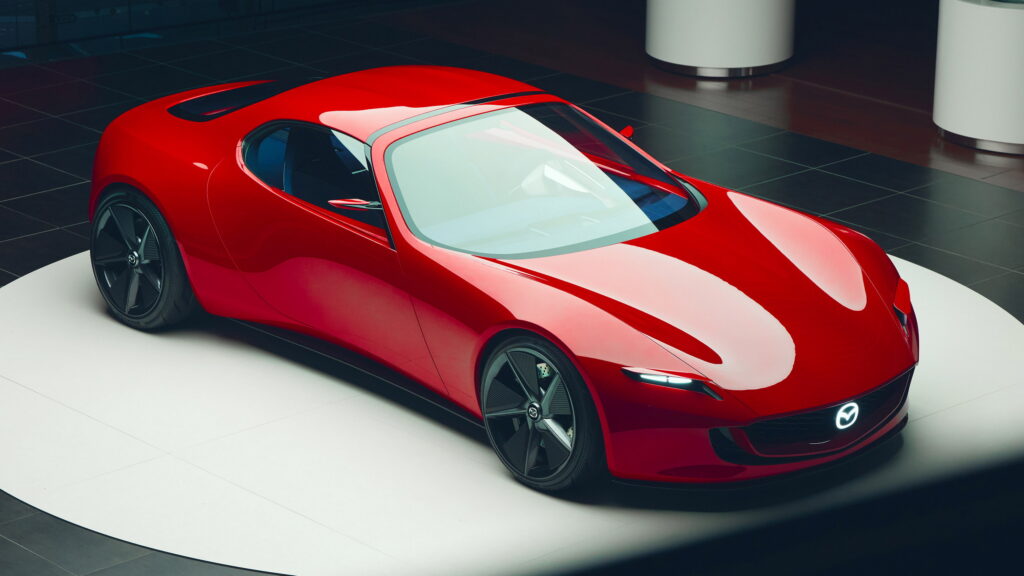Mazda’s Future Plans Reveal What It Thinks Drivers Actually Want Next

- Mazda is expanding its electrified SUV lineup with an in-house hybrid CX-5 arriving in 2027.
- The brand aims to sell 250,000 units of the similarly-sized CX-5 and CX-50 hybrids annually.
- EVs and sports cars are also in the pipeline, including a spiritual successor of the iconic RX-7.
Mazda isn’t diving headlong into the electric transition, but it’s not standing still either. Instead, it is following a measured path, blending hybrid models with steady electrification efforts and continued updates across its core lineup. This includes a hybrid CX-5, updated sales targets, future EVs, and even new sports cars.
The company recently introduced a new generation of its top-selling model, the CX-5. While the redesign matters, the more significant news is the addition of a hybrid powertrain set to arrive in 2027. This move expands Mazda’s range of electrified SUVs in the US, aiming to attract more buyers during a time of shifting attitudes toward EVs and growing uncertainty around tariffs.
More: One Country Asked Mazda For Something And Actually Got It With The CX-5
Through the first half of 2025, Mazda reported global sales of 636,968 units, a 2.6% year-over-year increase. The US remained its largest market with 210,297 units sold, up 3.9%, while sales surged 18.7% in Japan but declined in Europe and China by 12.2% and 18.7%, respectively.
According to Automotive News, the company has revised its US sales target of 450,000 units for 2025 in response to potential tariffs and is monitoring the market closely, though pricing for imported models has not yet been adjusted.
A Hybrid-Focused Core Lineup
Mazda’s current lineup in North America includes an electrified version of the locally-produced CX-50 compact SUV with a Toyota-sourced hybrid system, as well as plug-in hybrid options for the larger and more premium CX-70 and CX-90 twins. In 2027, these will be joined by a new variant of the third-gen CX-5 fitted with an in-house developed hybrid powertrain based on the new 2.5-liter SkyActiv-Z engine.


The automaker expects its two similarly-sized hybrid SUVs that compete in the hugely popular compact segment against the Toyota RAV4 will result in combined annual sales of 250,000 units in the US. However, before that happens, the new CX-5 will reach dealers with a gasoline engine in 2026.
More: Mazda Just Made The Same SUV Twice But Swears You’ll Want Both
Although the CX-30 is smaller by US standards, it holds the position as Mazda’s third-best-selling vehicle in the region, just behind the CX-5 and CX-50. Introduced in 2019, the CX-30 will continue with minor updates until a new generation launches in 2029.
Likewise, the CX-50 that arrived in late 2021 might get a comprehensive redesign in 2030. As for the CX-70 and CX-90, they will reportedly benefit from mild facelifts in 2026, with new generations arriving after 2030.
Finally, the Mazda3 that is available in hatchback and sedan forms and remains largely unchanged since 2018 is expected to carry on for at least four more years. According to the latest reports, a new generation of the model could arrive in 2032.

The BEVs Of The Future
Mazda plans to launch the mechanically related Mazda6e sedan and CX-6e SUV in Europe and Australia, both originating from its Chinese joint ventures. However, US customers may have to wait a bit longer before they see a fully electric Mazda on showroom floors.
The first EV developed entirely in-house is slated for a 2027 debut and could reach US dealerships in 2028. Though details remain under wraps, the vehicle is expected to be a crossover and will likely pave the way for more electric models as Mazda moves toward its 2030 targets.
What About Sports Cars?

If the SUV-heavy lineup isn’t quite your thing, there’s still good news. Mazda has two sports cars in development, each aimed at reviving the brand’s enthusiast credentials before the decade wraps up.
More: Mazda Is Bringing Back The Rotary RX-7 And Building A New Miata
The most exciting arrival is the production version of the 2023 Mazda Iconic SP Concept fitted with a rotary range-extender electric powertrain. Reports from Japan suggest we might first lay eyes on the new sports car as early as next year, although others expect it in the first half of 2028.
Either way, the low-slung two-door coupe is designed to be a spiritual successor to the RX-7, rather than a replacement for the MX-5.
Also: Mazda’s Stunning Vision SP Morphs Into Next-Gen MX-5
On that note, the MX-5 is getting a new generation as well. Development is already underway, and the next iteration of the world’s most popular roadster could launch in 2029. Encouragingly, it’s expected to keep its four-cylinder gasoline engine and further refine its reputation for agile, accessible performance.